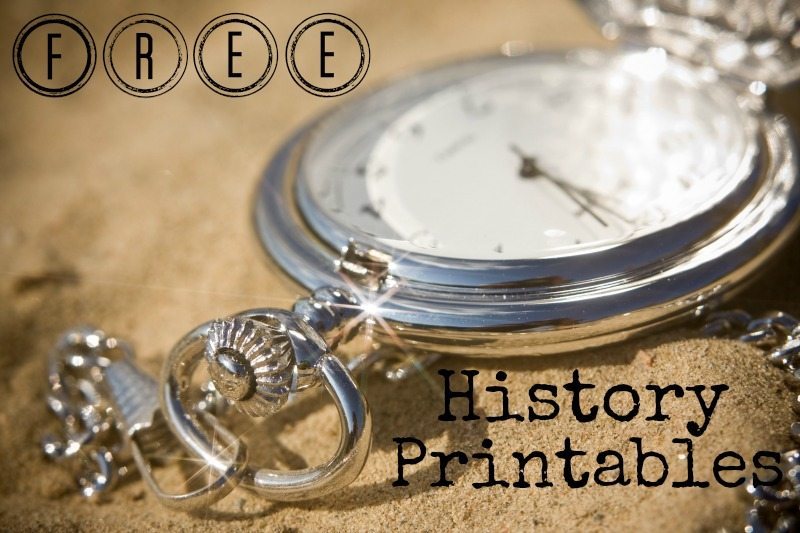How to Use Tapestry of Grace’s Supplemental Products
A few weeks ago, I shared with you about the comprehensive classical history curriculum Tapestry of Grace, which uses a history-themed unit study approach to studying history, language arts, geography, Biblical worldview, philosophy, and government. Today, I’d like to expand on this curriculum by showing you five supplemental products that extend this curriculum.
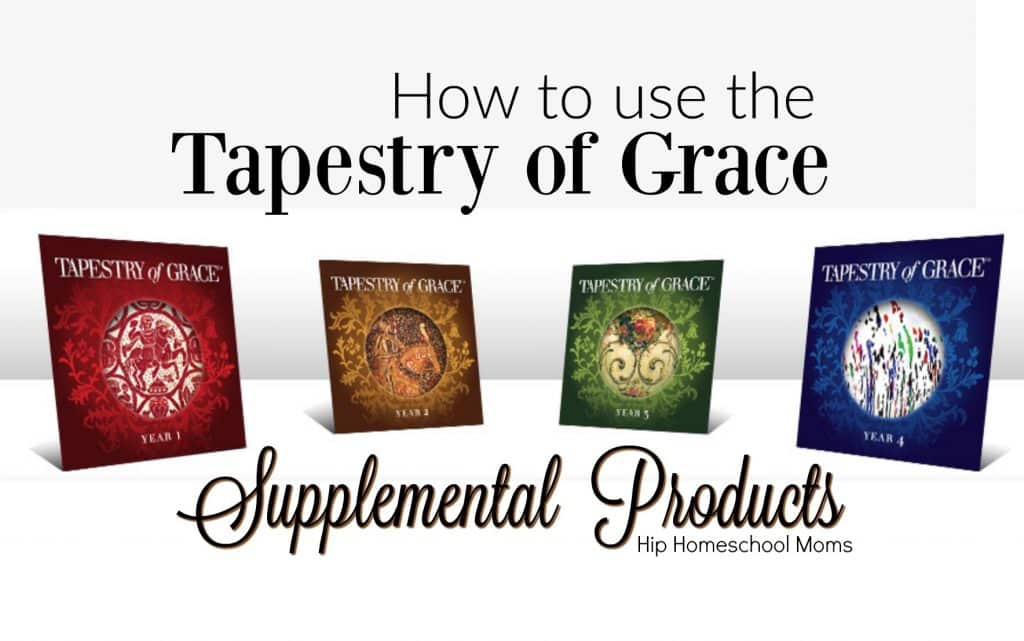
Tapestry of Grace is designed for students in grades K-12 and is divided into 4 primary levels — lower elementary, upper elementary, dialectic, and rhetoric. Over the course of 4 years, students cycle through the history of the world, which has been divided into 4 main eras, or “years” — the Creation and Ancient Civilizations (Year 1); the Middle Ages through the American Revolution (Year 2); American and World History during the 1800’s (Year 3); and the 1900’s through Current Events (Year 4). Each year contains 36 weeks of lessons which are divided into four large units. Each year contains all instruction for all 4 levels of learning.
To supplement this curriculum package, Tapestry of Grace created five additional products that are designed to help the parent plan out the curriculum and supplement the instruction. The products are: Planning Aids, Map Aids, Writing Aids, Lapbook, and Evaluations. Let’s look at each in more detail!

Planning Aids
For those who love the feel of a “boxed curriculum” where everything is planned out day-by-day, you will truly appreciate the Planning Aids. These aids explain what should be taught each week compared to what is optional. They also list the books and supplies needed for the week and divide the curriculum into daily tasks for 4, 5, 8, and 10 days per “week.” Each item on the list has a checkbox next to it, so you can check off your supplies as you are gathering them. If you prefer to customize your week, blank planning pages are also included.
Cost: $12.50 per level, per year for each of the grammar levels. Planning Aids are not available for the dialectic and rhetoric levels.
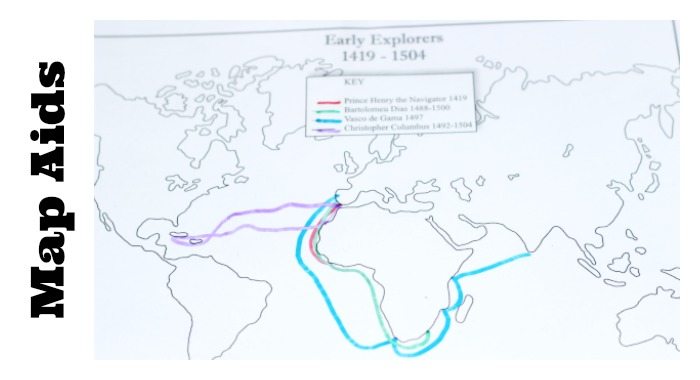
Map Aids
Included in the Map Aids are a series of maps to be used with the Tapestry of Grace curriculum. The maps are created by Terri Johnson of KnowledgeQuest. Which map you would use is determined by your student’s level – dialectic/rhetoric stages or grammar stages. A Teacher’s Edition is also included. All answers are labeled on the map, and a black and white transparency map is also included.
All maps are correlated with the week’s studies.
One of the most interesting optional aspects of the Tapestry of Grace curriculum is the creation of the Transparency Map project. This map project illustrates the progression of history and people across the geography of a continent. A map is printed on cardstock, and then layers of transparencies are stacked on top of one another. As you study a geographic location, you add this information to a separate transparency, and then place it on top of the other transparencies. One note… this project is not for the faint of heart, as it is more costly and time consuming, but it is very hands-on and beneficial for visually demonstrating how people and societies changed over time. The details for this project are outlined in the Loom.
Cost: $35 for all maps in one level, or you can purchase just the grammar level maps for $10 and the upper grades maps for $12 for one level.
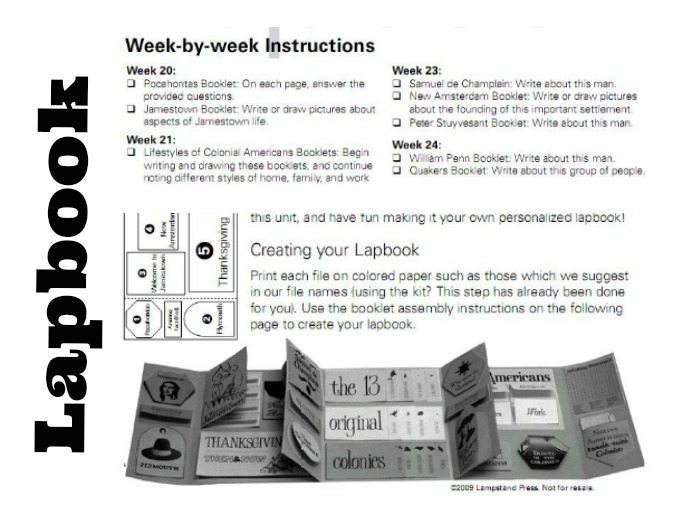
Lapbook
If you are looking for a hands-on writing or review component for Tapestry of Grace, check out their Lapbooks. For each unit, you’ll receive the individual lapbook components as well as a week-by-week instruction guide, booklet assembly instructions, and instructions on how to lay out the complete lapbook.
The week-by-week instructions detail which booklets to use each week so you know exactly which booklet to include at the appropriate time. Likewise, they give directions explaining what to write or draw. For instance, on week 20, the student is to complete the Pocahontas and Jamestown booklets. For the Pocahontas booklet, you answer the questions at the top of each page, while for the Jamestown booklet, you can draw or write your answers about Jamestown life.
If you are ever unsure how to assemble the booklet, the Booklet Assembly Instructions clearly state how they are to be assembled, and the Getting Started page illustrates where to lay out each component across three lapbook folders. I love that they share an image of what the complete lapbook looks like once constructed.
Cost: $65 for the digital/CD for one complete year or $55 for one complete set, printed on colored paper. You can also purchase the lapbook components by the individual unit for $17.50 for the digital version and $15 for the printed version.
Writing Aids
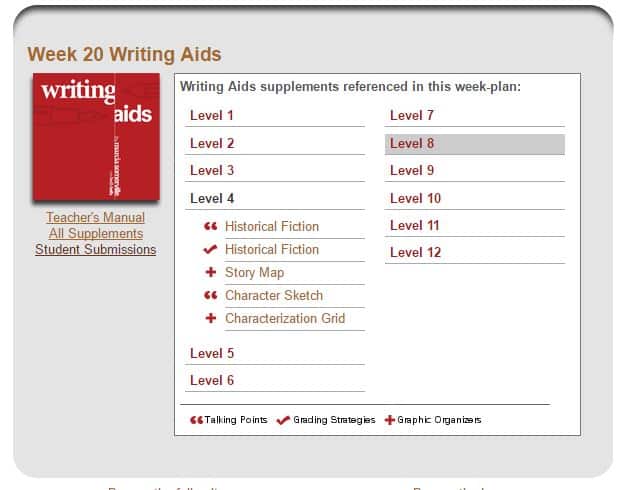
Within each year of the Tapestry of Grace curriculum, a writing component is included within the instruction. This is divided into 12 ability levels. This way, you can determine the appropriate writing level for your child! Depending upon the ability level, your child will learn about various styles and components of writing.

The Writing Aids were created to assist the parent by explaining each language arts concept to the child as well as illustrating appropriate writing level expectations for the parent. For instance, my son is in 4th grade, and his ability is around level 3 or level 4 for writing. For Year 2 Unit 3, one focus was on Historical Fiction. You can see where it mentions the suggested writing ideas within the main curriculum. However, it is within the Writing Aids that fully explains the details of this type of writing as well as gives suggestions for appropriately grading this type of writing assignment.
Cost: $40 for the digital version; $50 for the CD; and $60 for both the digital version and CD. (All levels, across all years are included in this one resource.)

Evaluations
From maps to writing prompts to hands-on lapbook components, I have yet to mention my favorite supplemental products for Tapestry of Grace — their evaluation forms!
I am not a huge fan of testing my son, primarily because he struggles with reading. The issue is not that he does not know the information; instead, it is a matter of him not always being capable of reading the question and writing the solution. However, I absolutely LOVE Tapestry of Grace’s evaluations. In fact, the lower levels entirely take the stress off of determining if lower and upper elementary children have learned the content for the week. To my delight, the quizzes are administered orally!
For each week, you’ll find a list of questions covering the content from the reading as well as the answers to those questions. As with all of Tapestry of Grace’s products, you can adjust the questions so that you are asking just a few or all of them. If your child needs a little prompting, you can also use part of the details found within the answer to each question as a trigger. Tapestry of Grace also provides a record chart, for you to record your child’s oral answers and then to evaluate them according to whether the answer was excellent, good, fair, or poor. Likewise, for upper elementary, Tapestry also provides different comprehensive assessments, such as a fill-in-the-blank, true and false, and matching exercises.
For the dialectic and rhetoric levels, you’ll find open-ended questions, compare and contrast charts, relationship flow charts, and much more. Each unit also has a comprehensive exam that covers the topics studied on the timelines, geography, and major topics. There is even a literary terminology test, if you are focusing on the literary analysis!
Cost: $70 per year for all levels or $20 per year, per level.
How We Used the Supplements
We have a very eclectic method of merging lapbooks with the notebooking approach. Naturally, we merged the supplemental aids for Tapestry of Grace into one large notebook.
First, we studied the core content for each week, found in the main curriculum. Then all of the supplemental products were added sequentially within the notebook. It includes:
- Map Aids
- Lapbook components
- Drawings, activities, worksheets, and assignments completed from the coursework
- Writing Aids
- Evaluation questions and grading rubrics
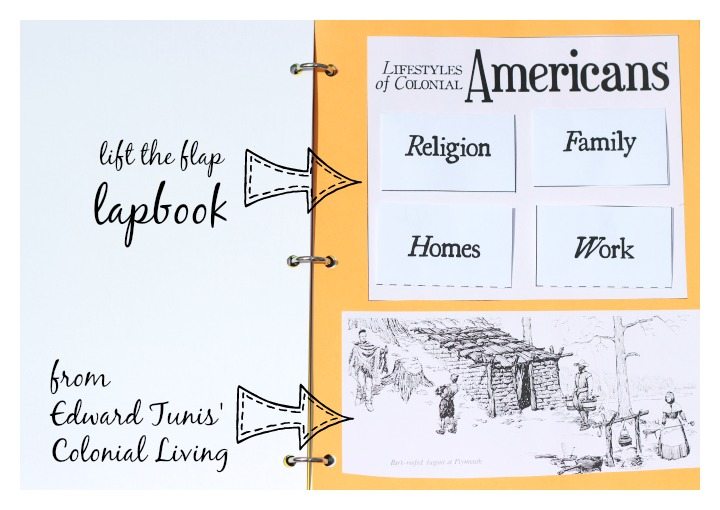
One of our favorite books for this study was Edward Tunis’ Colonial Living. The details were thorough and the illustrations were AMAZING! If an illustration really helped to explain what we were studying, we copied the book and glued it right on the page with our lapbooking components. You can also add in pictures taken of the hands-on projects completed and of the End of Unit celebration. Likewise, if you complete the End of Unit evaluation, you can add it at the end as well.
The finished product is a week-by-week review of our studies. It shows how much information we’ve learned over time and can be used to refresh and review information.





